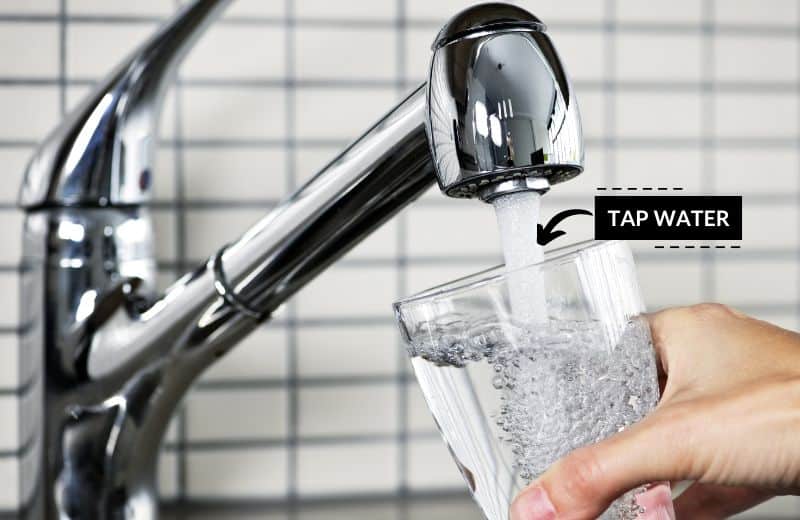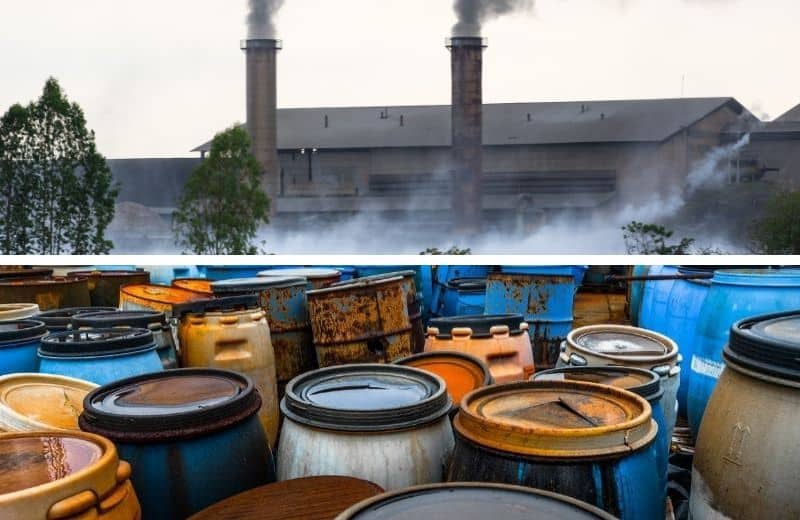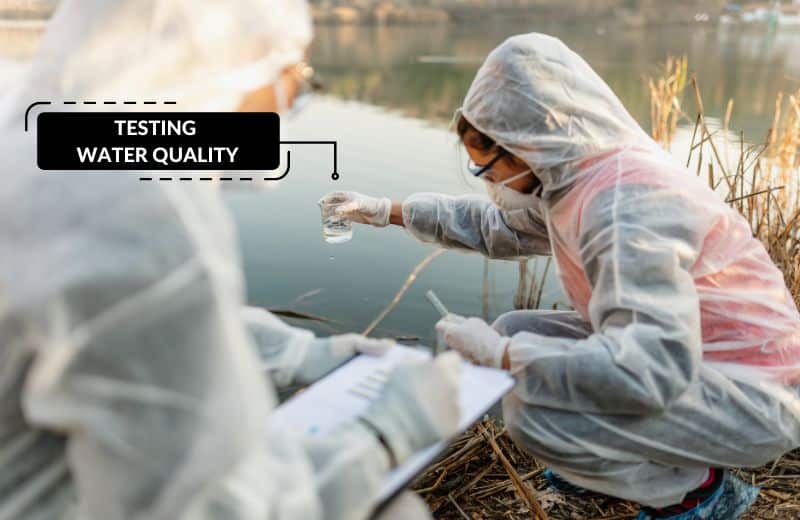Is it safe to drink the tap water in San Francisco? How does San Francisco’s tap water compare to the water in nearby cities and other parts of the country? Are there any contaminants in the City’s water, and do any of these violate EPA standards or the Safe Drinking Water Act?
You can find all the important information about San Francisco tap water quality and safety in this guide.
📌 Key Takeaways:
- The drinking water in San Francisco, California is considered generally safe to drink.
- There were a few contaminants detected in San Francisco’s tap water, but these are present in concentrations lower than the EPA Maximum Contaminant Levels.
- The 2 biggest problem contaminants in San Francisco tap water are disinfection byproducts ad hexavalent chromium (chromium-6).
Table of Contents
- 🚰 Can You Drink San Francisco Tap Water?
- 🗺️ Where Does the Tap Water in San Francisco Come From?
- 📉 Who Regulates San Francisco Drinking Water?
- 🧪 San Francisco Annual Water Quality Report
- ☣️ Contaminants Found Above Guidelines in Tap Water in San Francisco
- 🧫 Main Contaminants Found in San Francisco Tap Water
- ⛲ San Francisco Drinking Water in Public Places
- 💬 Frequently Asked Questions
🚰 Can You Drink San Francisco Tap Water?
Yes, you can drink San Francisco tap water because the City’s water treatment plants disinfect and filter the water to make it potable and legally safe for drinking.

San Francisco’s water complies with regulations set by the Environmental Protection Agency (EPA) and doesn’t have any known violations of the Safe Drinking Water Act (SDWA). The City’s water does contain contaminants, but these are present in concentrations that don’t surpass the EPA’s maximum allowances.
So, San Francisco ensures that its water is legally safe to drink – but safety and health are two different things.
Maybe you don’t want to drink even trace amounts of contaminants in SF tap water, and maybe you think these trace amounts could still harm your health. This is the opinion of the Environmental Working Group (EWG), an independent organization that thinks the EPA’s Maximum Contaminant Levels aren’t strict enough.
The EWG has produced its own, much stricter version of the EPA’s MCLs, called Health Guidelines, and has compared the contaminants present in San Francisco tap water to these Guidelines in its Tap Water Database for the City. According to this Database, 5 contaminants exceed EWG Health Guidelines in SF drinking water.
Note that the EWG’s Health Guidelines aren’t a legal matter, so if a water utility violates EWG guidelines, there are no repercussions.
Lead is a contaminant that has the biggest impact on drinking water safety, but luckily for San Francisco residents, the community water system appears to be lead-free.

The San Francisco Public Utilities Commission replaced its known lead pipes in the 1980s as part of its Lead Service Line Replacement Program, and the agency says that no lead is detected in the City’s water. However, note the wording “known lead pipes” – there may be lead pipes in the distribution system that haven’t been identified. Plus, this Program only focused on main distribution lines and not goosenecks (the pipes that deliver water from the main system to individual properties) or old household plumbing systems.
You can apply to get your water tested for lead by the San Francisco Public Utilities Commission (it’ll set you back $25 for a single test).
👨🔧 Find out which states have some of the poorest-quality drinking water
🗺️ Where Does the Tap Water in San Francisco Come From?
The drinking water in San Francisco comes from a number of sources that are protected and managed by the City’s water provider, the San Francisco Public Utilities Commission (SFPUC). By maintaining a diverse range of water sources, the City hopes to protect its water supply against potential disruptions caused by drought or natural disasters.
Some of the City’s water sources include:
- Surface water sourced from reservoirs in Alameda County, the Sierra Nevada, and San Mateo County
- Groundwater sourced from deep aquifers beneath San Mateo and San Francisco
The Hetch Hetchy reservoir in Yosemite National Park, supplied by the Tuolumne River, is said to be one of the biggest water sources for San Francisco, supplying around 85% of the City’s tap water.
Water is supplied to these sources in numerous ways, including rainfall, snowmelt, and soil seepage.
Surface water supplies often have poorer-quality water than groundwater supplies because they’re open to the elements and may be contaminated by surface runoff and air pollution.
Regardless of the source, water supplied to the City is treated using largely the same processes, including coagulation, flocculation, disinfection with chloramine (a combination of chlorine and ammonia), filtration through sand and coal filters, and fluoridation.
To ensure that it meets federal regulations and local water quality standards, the City monitors its water quality and performs hundreds of water tests per year.
After treatment, water is stored in eight water tanks and 12 in-City reservoirs before being distributed around the City in more than 1,250 miles of distribution pipelines to homes and businesses.

📉 Who Regulates San Francisco Drinking Water?
The City of San Francisco drinking water is regulated by the Environmental Protection Agency (EPA) and managed by the San Francisco Public Utilities Commission (SFPUC).
The utility must suitably treat the City’s water before it is delivered to homes and businesses in the community water system. The EPA has specific regulations for removing contaminants and monitoring water quality that SFPUC must comply with.
According to the EPA’s drinking water regulations, the SFPUC must ensure that none of the trace contaminants in the City’s water supply exceed the EPA’s Maximum Contaminant Levels (MCLs), ensuring that water is safe to drink and drinking water quality doesn’t fluctuate.
San Francisco rigorously tests and protects its drinking tap water, but if you have an issue with your water quality, you can report it here.
🧪 San Francisco Annual Water Quality Report
The latest Water Quality Report (or Consumer Confidence Report) for San Francisco tap water is dated from January 2021 to December 2021.
This Report details information including:
- Where the local tap water is sourced
- How this water is treated to make it safe to drink
- How the water’s contaminant levels compare to EPA legal limits
According to the Report, the tap water in San Francisco is safe to drink because none of the detected contaminants were present above the EPA’s MCLs.
Does this mean that you should happily drink tap water in the City? Not necessarily.
For instance, the average recorded concentration of haloacetic acids (HAA5) in San Francisco tap water was 28 PPB (parts per billion) – well within the EPA’s MCL of 60 PPB, but perhaps you don’t want to drink even trace amounts of these cancer-causing disinfection byproducts.
Some of the contaminants listed in the Report include:
- Total trihalomethanes
- HAA5
- Bromate
- Chloramine
- Fluoride
- Copper
- Chromium-6
- Nitrate
The Report highlights which contaminants were found in which concentrations in various water sources, including unfiltered water from the Hetch Hetchy Reservoir, filtered water from Sunol Valley Water Treatment Plant (SVWTP), filtered water from Harry Tracy Water Treatment Plant (HTWTP), treated water at Sunset Reservoir, and raw water in San Francisco groundwater wells.
When you read through the water quality data, remember that it only applies to the year of issue. The EPA guidelines are occasionally reevaluated or updated, and unregulated contaminants could eventually obtain MCLs.

☣️ Contaminants Found Above Guidelines in Tap Water in San Francisco
San Francisco water might be legally safe to drink, but that doesn’t mean that the water is contaminant-free.
Here, we’ve shared the contaminants found above EWG guidelines* in the City’s tap water:
*As a reminder, the EWG guidelines aren’t legally enforceable, but they reflect the popular opinion that the EPA MCLs are too lenient.
Haloacetic acids (HAA5)† and Haloacetic acids (HAA9)†
HAA5 and HAA9 are two of the most common disinfection byproducts. These haloacetic acids have known cancer-causing effects and have been found to increase the incidence of liver and bladder cancers. 31.9 PPB (parts per billion) and 39.5 PPB of HAA5 and HAA9 were detected in the water supplied to San Francisco residents, which is between 319 and 658x the EWG’s Health Advisories of 0.1 PPB and 0.06 PPB. While the EPA does regulate HAA5 (the legal limit is 60 PPB) HAA9 is currently unregulated.
Hexavalent Chromium
Chromium-6, otherwise known as hexavalent chromium, is a chemical compound that contains chromium in the toxic +6 oxidation state. Potential health effects of drinking large quantities of chromium-6 include improper skeletal development, low body weight, and liver and reproductive system damage. Despite this, the EPA currently doesn’t regulate chromium-6 alone (only total chromium, which also includes harmless forms of the chemical). The EWG has a recommended Health Guideline of 0.02 PPB for hexavalent chromium – and 0.0906 PPB of chromium-6 was detected in San Francisco tap water, exceeding this Guideline by 4.5x.

Total trihalomethanes (TTHMs)†
Total trihalomethanes (TTHMs) are commonly found in tap water alongside haloacetic acids and have similar health effects, including the increased risk of cancers like colon and bladder cancer. Consuming large quantities of these disinfection byproducts may also result in reproductive problems and birth defects. The EWG detected 41.1 PPB of TTHMs in San Francisco water – well within the EPA’s legal limit of 80 PPB but 274x the EWG’s recommended Health Guideline of 0.15 PPB.
Carbon Tetrachloride
0.725 PPB of carbon tetrachloride, an occasional byproduct of chlorine disinfection that may cause liver and kidney damage, was detected in San Francisco’s community water supply. The EWG recommends that no more than 0.1 PPB of this chemical is present in drinking tap water – and the concentration in San Francisco’s water is 7.3x this amount (but still within the EPA’s legal limit of 5 PPB).
Like most community water systems in the US, San Francisco’s biggest water quality issue (according to the EWG) is disinfection byproducts.
Disinfection chemicals offer a cheap and effective method of maintaining potable water in a large-scale setup, which is why they’re still the preferred method over non-chemical, more expensive methods like UV purification for public water treatment – regardless of the growing evidence of their byproducts’ health effects.
👨🔧 If you’re concerned about drinking disinfectant byproducts or any other trace contaminants in San Francisco’s water, we recommend filtering your water to remove these impurities at home.
🧫 Main Contaminants Found in San Francisco Tap Water
There are a few other contaminants found in SF tap water that are present in amounts that neither the EPA nor the EWG deems to be unsafe:
- Aluminum – A non-toxic element that may be used during water treatment or may enter water from pipe materials; more easily absorbed in water than in food and may cause nervous system effects (such as Parkinson’s and Alzheimer’s) if consumed in high concentrations.
- Chlorate – Another common byproduct produced when chlorine dioxide or sodium hypochlorite (two chemical disinfectants) react with organic matter in the water; ingesting large amounts may lead to an enlarged thyroid, liver damage, or an increased risk of various cancers.
- Fluoride – A mineral that’s found naturally in the environment but is often produced artificially and added to community water supplies for its dental health benefits; there are minimal risks of drinking low levels of fluoride but high concentrations may increase the risk of developing skeletal and dental fluorosis (particularly in infants and children).
- Manganese – A hard water mineral that is safe to drink but causes damage to pipes and water-using appliances; its presence is characterized by scale deposits on surfaces, poor lather with soap, dry skin and hair, and soap scum.
- Quinoline – A naturally occurring substance that’s used to make petroleum and coal tar; may also be produced due to fossil fuel processing and extraction; potential health effects include an increased risk of certain types of cancer, changes in the blood, and kidney and liver damage.
- Strontium – A heavy metal that may replace calcium in the bones due to its similar properties; high levels may disrupt normal bone structure but small amounts should be safe to drink.
- Total chromium – Refers to chromium-3 (or trivalent chromium) and chromium-6 (or hexavalent chromium) in water; chromium-3 is considered safe but chromium-6 is harmful to humans, with cancer-causing effects.
- Vanadium – A metal that is naturally released into soils and water due to erosion and weathering; not harmful to health when consumed in low levels.

⛲ San Francisco Drinking Water in Public Places
The drinking water in public places, like bars, hotels, and restaurants, is the same in San Francisco as the water that’s delivered to homes and businesses.
That means you can safely drink the water in public places – to some extent.
Restaurants and bars aren’t legally required to offer free tap water to patrons, and there may be restrictions in place at certain times due to drought. However, you should usually be served tap water for free if you ask for it.
Hotels should have drinkable water in their rooms, but this isn’t always the case. Some hotel bathrooms have plumbing made from lead. If you’re staying in an old hotel or your bathroom sink doesn’t look like it provides water that’s safe to drink, check with reception or ask for tap water at the bar.

You can choose to avoid drinking the water in public places and buy bottled water instead – but it’s better not to make a habit of this since bottled water is bad for the environment.
Continue Reading:
💬 Frequently Asked Questions
Why is San Francisco tap water so good?
Tap water in San Francisco is better than other tap water supplies in the country because the City’s various water sources, including the Hetch Hetchy Reservoir, are closely protected and well-managed. The City also markets its tap water as being comparable to bottled water, giving the impression that the water quality is exceptional. However, unlike bottled water products that have been thoroughly filtered, San Francisco water still contains trace amounts of contaminants that may affect human health.
Is sink water safe to drink in California?
Yes, sink water is safe to drink in California as long as the sink is connected to the community water system and isn’t plumbed in with lead pipes. Bathroom sink water may not be safe to drink in California since the plumbing used in these sinks often contains lead, which may leach into the water.
Is San Francisco tap water hard or soft?
San Francisco tap water is one of the softest water supplies in California, with an average water hardness of 47 PPM (parts per million). This falls into the “soft water” category (50 PPM of hardness or lower). You shouldn’t notice major hard water problems in your home, though you may still experience some scaling and issues with soap scum.
Does San Francisco tap water have fluoride?
Yes, San Francisco water has fluoride – the City has been fluoridating its water for over 50 years. Fluoride is added to most municipal water supplies in the US because it’s considered a healthy mineral and protects the tooth enamel, preventing tooth decay. However, even low levels of fluoride can cause discolored tooth enamel, known as dental fluorosis. The City’s water utility monitors its water’s fluoride content and submits fluoride test results every month, which you can view here.
How is San Francisco water disinfected?
San Francisco water is disinfected with chloramine, made from chlorine and ammonia. Chloramine is recognized as a safe disinfectant and has a few advantages over chlorine, including that it lasts longer in water and is less reactive with organic materials, so should produce fewer unwanted disinfection byproducts.
Can you drink tap water in Bay Area?
Yes, you can drink tap water in the Bay Area because the water is treated to ensure it is legally safe to drink (according to EPA regulations). However, you might want to use a water filter to remove trace contaminants and improve water’s taste and safety. Drinking filtered delicious tap water costs far less than bottled water.
